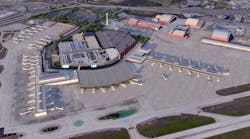... and causes a stir. The Wall Street Journal says that the department’s announcement on Monday to allow U.S. airports to impose congestion pricing was “a move that caught the airlines off guard.†Probably not. FAA has been nudging along in this direction for a decade and it’s been a prominent part of the discussion for the past year on how to reduce congestion at New York’s airports. What was once sacrosanct – not allowing airports to set rates & charges at will to control activity – is now out the window with the proposed policy.
DOT says the policy change, published in a notice of proposed rulemaking (NPRM), would “make it easier for airports to add capacity and reduce congestion†by allowing them the flexibility to vary charges based on time of day and volume of aircraft. The idea is to prod airlines into spreading out traffic at high-density airports, thereby reducing congestion.
A significant change will allow airports to build into their fees the costs of projects designed to expand capacity, which DOT says will bring lower overall construction costs by helping airports avoid finance fees. The shift would also allow airport sponsors that operate more than one commercial facility, ala the Port Authority of New York & New Jersey (PANYNJ), to distribute landing fees among those airports. Thus, the Port Authority could take money collected at its Big 3 airports and divert it to improvements at Stewart to encourage more utilization there.
Airports Council International-North America immediately embraced the move as one that affords airports more control over the use of their facilities. Others, including the Port Authority, question whether this is the proper cure for the congestion disease. The PANYNJ, in particular, has been calling for better management of the Northeast airspace by FAA.
Count Jim Coyne, president of the National Air Transportation Association, among the skeptics. He participated in the PANYNJ Task Force this past fall that made a host of recommendations to FAA on how to alleviate the congestion at New York’s airports.
One concern, says Coyne, is that the policy change could evolve into airports being allowed to regulate which traffic uses which airports in its system, which could threaten NATA members, particularly FAR Part 135 charter operators. But to Coyne, the biggest issue is imbedded in the combative relationship which the agency now has with the controller community.
Says Coyne, “It’s important to understand that the numbers of actual aircraft at the major New York airports is virtually no higher than it was 15 years ago. You would think listening to all this rhetoric ... that there was a 30 percent increase. In fact the growth has been under 1 percent over past ten years at New York’s airports; GA ops have grown less. The only thing that’s changed is the move to more regional aircraft which has accounted for the only significant increase.
“I think it could be fixed if FAA and the controllers union could work more closely together. Marion Blakey came down hard on the controllers on aircraft separation, and the result was the controllers being careful not to have any violations of policy. It seems to me the airlines are being blamed for things FAA should be blaming itself for.â€
Coyne says that during his meetings with the Port Authority Task Force it became evident that the city’s airports could increase operations significantly if a more trusting relationship could be developed between the controllers and their FAA managers.
He adds, “The work rules, the safety margins were set 40 years ago. We need new rules based on more sophisticated technology. I wonder when FAA will have the courage to stand up and say we need to change the rules on separation because the technology today allows for it, without reducing safety at all. Everyone is afraid of making any changes.â€
Thanks for reading. jfi



